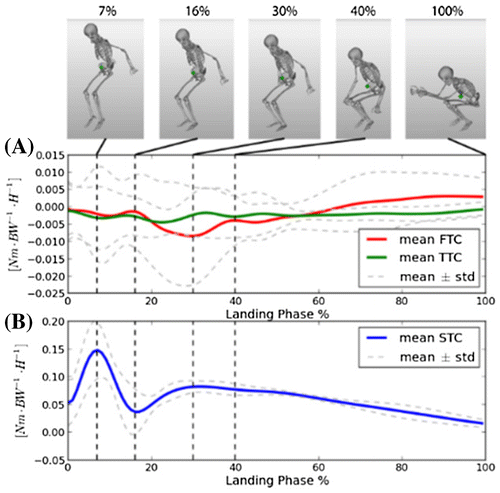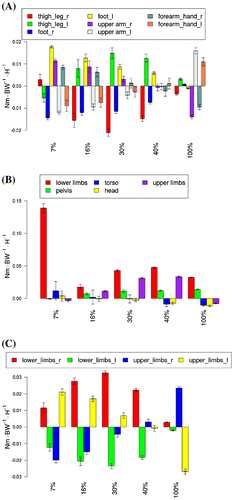 ?Mathematical formulae have been encoded as MathML and are displayed in this HTML version using MathJax in order to improve their display. Uncheck the box to turn MathJax off. This feature requires Javascript. Click on a formula to zoom.
?Mathematical formulae have been encoded as MathML and are displayed in this HTML version using MathJax in order to improve their display. Uncheck the box to turn MathJax off. This feature requires Javascript. Click on a formula to zoom.1. Introduction
Angular momentum has been observed to be regulated during daily life activities such as walking (Herr and Popovic Citation2008) and more complex motions like somersaults and twists (Frohlich Citation1979). In recent studies, information from angular momentum observed in human motions has been transferred to generate motion of anthropomorphic avatars (Hofmann et al. Citation2009) and to control bipedal robots. According to Euler’s second law of motion, the derivative of this Angular Momentum (DAM) expressed at the center of mass ‘CoM’ is equal to the sum of the external net torques applied to the body. This sum can be regulated by humans when contacting the ground at landing to maintain equilibrium and avoid tipping motions (Sardain and Bessonnet Citation2004). Motivated by these studies, we propose to analyze the DAM in a complex and highly dynamic three-dimensional landing task performed by Parkour experts called ‘traceurs’. Thus, we hypothesized that traceurs regulate the DAM among the three axes of rotation. To extend our analysis, we studied postural control strategies by looking into segmental contributions to the total DAM.
2. Methods
Five healthy trained male traceurs (age: 22.2 ± 4.8 yrs, height: 1.73 ± 0.04 m, mass: 66.6 ± 5.1 kg) volunteered for this study. The experiments were conducted in accordance with the standards of the Declaration of Helsinki (rev. 2013). The landing protocol was designed to include a jump height of 75% of their height and a landmark was placed at a distance equal to the square of the jump height. Traceurs were instructed to land on the landmark and to stabilize themselves using the Parkour precision technique. The DAM was divided by body weight (BW) and subject’s height (H) to be expressed in a dimensionless form. 5 successful repetitions per participant were recorded. Whole-body 3D kinematic data were collected using 14 infrared cameras sampling at 400 Hz and recording 48 reflective markers placed on the participant body. The landing motion was normalized from initial contact with the ground to minimum vertical center of mass position. The motion was divided in 4 phases for analysis after inspection of the DAM profiles expressed at the CoM. A whole-body skeletal model of 25 segments was used for the study. Kinematic and anthropometric data were merged to compute the DAM contribution of each segment k ( according to the following equation:
(1)
(1)
where Ik is the inertia matrix of the kth segment, is the angular velocity of the kth segment, each expressed in the inertial frame (CoM) of the segment. Using Equation (1), individual contribution of segments was expressed at the system CoM and summed in order to analyze the whole body postural control strategy.
3. Results and discussion
The observation of the regulation around zero of the antero-posterior (A-P) and the vertical (V) axis components of the DAM, revealed that each pair of segments (right/left arms, thighs, etc.) produces two opposed contributions to the total DAM that tend to cancel each other. In this study, we will refer to this observation as opposed segments cancellation strategy. At the beginning of the landing, pelvis, torso and head are not used for stabilization, while upper and lower limbs work together to regulate the DAM around the three axes. Adjustments of the total DAM due to upper limbs movements in the frontal and transversal planes, were observed in the end of the motion.
3.1. Frontal DAM around A-P axis (FDAM)
FDAM is regulated around zero with small variations (+/-0.01 Nm.BW−1.H−1). A strategy of right and left segments cancellation is observed (Figure (A)) which contributes to minimize the FDAM. In the beginning of the landing phase (up to 40%), the control comes from lower limbs contribution especially. This might be a strategy of the jumper to avoid excessive varus-valgus motions. Furthermore, an important opposed segment cancelation strategy of the arms at the end of the motion phase is observed. This might be linked to the fact that the traceur has almost reached the lower limbs’ joint limits and therefore needs another strategy to control FDAM, involving arms which are free to move and can compensate the small remaining deviations.
3.2. Sagittal DAM around M-L axis (SDAM)
Figure reveals a perturbation rejection profile of the SDAM during the first 40% of the landing phase, in which the lower limbs contribution is considerable. This contribution seems reasonable given the amount of DAM to regulate in the sagittal plane after the Parkour jump (similar to a standing long jump).
3.3. Transversal DAM around vertical axis (TDAM)
TDAM is regulated around zero with small variations (+/−0.02 Nm.BW−1.H−1). Opposed segment cancellation strategy as in FDAM is used to keep TDAM low. The upper limbs segment cancellation is important in the end of the motion, and the same reasoning as in FDAM could be applied.
3.4. Segment cancellation interpretation
At first glance, opposed segment cancellation does not contribute to the DAM. We interpret it in terms of an energy storing strategy for eventual mechanical action to control stability. Eventual, because if the motion of pairs of segments stays symmetrical, the contribution is zero, otherwise, the opposed segment difference generates the required DAM at the CoM. In this way, mechanical action can be generated precisely and instantaneously (by making profit of the motion dynamics) instead of producing it from scratch.
4. Conclusions
The derivative of angular momentum (DAM) appears to be minimized by the mechanical actions of whole-body segments during a highly dynamic landing. This make sense as the DAM expressed at the CoM is directly linked to the body’s angular acceleration, according to Newton’s law. Our study reveals complex strategies of traceurs such as opposed segment cancellations and temporal organization of the motion. This study offers a theoretical base for generating human inspired dynamic motions for anthropomorphic avatars and humanoid robots.
References
- Frohlich C. 1979. Do spring board divers violate angular momentum conservation? Am J Phys. 47(7):583–592.10.1119/1.11759
- Herr H, Popovic M. 2008. Angular momentum in human walking. J Exp Biol. 211:467–81.10.1242/jeb.008573
- Hofmann A, Popovic M, Herr H. 2009. Exploiting angular momentum to enhance bipedal center-of-mass control. IEEE Int Conf Robot Autom. 4423–4429.
- Sardain P, Bessonnet G. 2004. Forces acting on a biped robot. center of pressure – zero moment point. IEEE Trans Syst Man Cybern A Syst Humans. 34(5):630–637.10.1109/TSMCA.2004.832811


